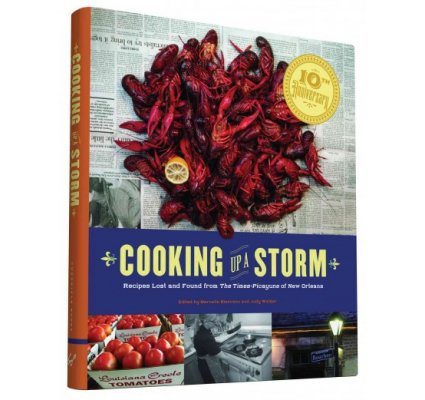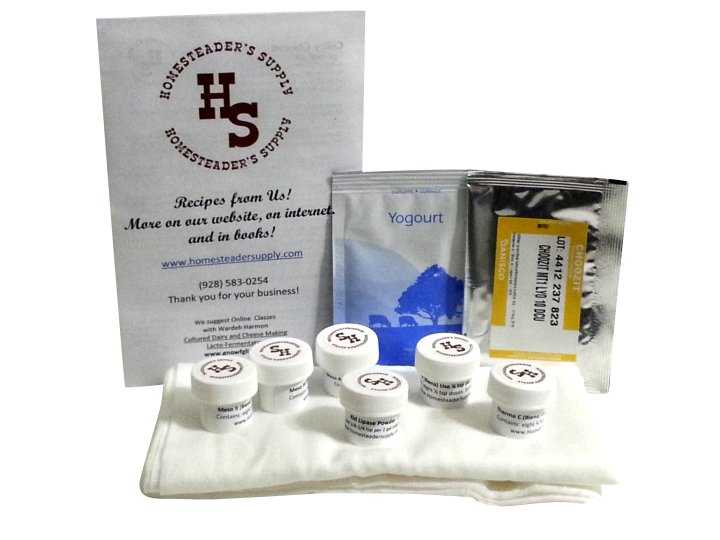|
|
Category Archives: Cheese Making
Cookbook Spotlight: Cooking Up a Storm
Cooking Up a Storm: Recipes Lost and Found from the Times-Picayune of New Orleans
Edited by Marcelle Bienvenu and Judy Walker
2015, 368 pages, Hardcover
When Hurricane Katrina ripped through New Orleans in 2005, many residents lost their homes. Along with their homes went all the contents, which included countless regional recipes from the Times-Picayune. These recipes had been clipped from the newspaper, saved, and cherished for generations.
To preserve the city’s culinary legacy, the people of New Orleans banded together to recoup these lost recipes, one by one. This book is a collection of the recipes recovered as a result of this effort. Each recipe has a story.
In this cookbook, you will find an impressive range of recipes, including appetizers, drinks, special Lenten dishes, and desserts. These foods are eaten as part of everyday life in the Big Easy. The recipes are favorites from both home kitchens and restaurants. Nothing says “comfort food” like Louisiana cooking!
This cookbook truly is a work of love and a symbol the city’s residents’ determination to recover from, and triumph over, extreme adversity.
Learn How to Make Creole Cream Cheese
Love cream cheese? Then be sure to check out How to Make the Best Cream Cheese in the World, featuring a recipe for Creole Cream Cheese from Cooking Up a Storm. Creole Cream Cheese is a unique, regional breakfast food that is served in a bowl and eaten with a spoon. You can sprinkle some sugar on top, or shake on some salt and pepper, or top it with your favorite fruit. No matter how you serve it, Creole Cream Cheese is a nutritious and satisfying food.
Why not make some and tell us what you think in the comments section at the bottom of this page?
Hat Tip!
We wish to thank a lovely customer of ours named Libby W. for bringing this unique cookbook to our attention. Libby kindly shared her recipe for Creole Cream Cheese with us, so we could share it with y’all. Thanks, Libby!
How to Make the Best Cream Cheese in the World

When it comes to cream cheese, there’s nothing like the homemade kind. It is more delicious than even the most popular store brand. The superb flavor of homemade cream cheese comes from quality ingredients.
Did you know that when you make cream cheese at home using a recipe that calls for cheese cultures, you can even tweak the flavor to suit your taste? Make it mild or aromatic (and slightly sharper) — it’s entirely up to you! The flavor just depends on which of the recommended cheese cultures you choose. Continue reading
Q&A: What is early cheese blowing?
Gail asked My cheddar cheese looked just fine while I was making it. But later, when it came out of the Ultimate Cheese Press, it looked like a sponge with lots of holes throughout. Why did this happen? And is this cheese safe to eat?
Jerri’s answer This is called early cheese blowing. There are two reasons why it can happen.
One possible cause is coliform bacteria contamination. These pathogens can infect milk when sanitary conditions get compromised during milking or milk processing. You don’t want to risk getting sick, so THROW OUT THE CHEESE!
The second possibility is yeast contamination, which is most likely to happen when you’re baking fresh breads and making cheese in the kitchen at the same time. Again, I recommend you THROW OUT THE CHEESE!
The latter situation is easier to remedy. If you’re baking yeast breads while making cheese, add your lactic culture to the milk when it’s still cold, just prior to the first heating to start making cheese. This way, the lactic cheese culture will grow faster during the initial heating of the milk. If any yeast does get into the milk, it won’t be able to grow and ruin your cheese.
Q&A: Why won’t my mozzarella cheese stretch?
A customer asked Help! My mozzarella cheese won’t stretch!
Stretching mozzarella
Jerri’s answer Acidity is the key for the stretch in mozzarella. Not enough or too much acid will result in hard curd floating or disintegrating in the water. The pH of your slab needs to be between 5.0 and 5.2 for it to stretch well when kneaded in hot water.
And the ripening of your slab is very dependent upon the weather. It can over-ripen in hot weather, or under-ripen in colder weather. One trick to standardize your mozzarella making year round is to ripen your slabs in the refrigerator for 16 hours.
Would you like to try making mozzarella the old fashioned way at home? Our REAL Italian Mozzarella Kit makes cheese with authentic Old World flavor. The mesophilic and thermophilic cheese cultures we use to make our mozzarella are imported directly from Italy.
Q&A: Cheddar cheese came out dry and brittle. Why?
A customer asked: I followed the recipe perfectly, but my cheddar cheese came out dry, and it has a brittle texture. What did I do wrong?
Jerri’s answer: There are three possibilities:
- You might have inadvertently added too much starter culture. Excess starter culture can lower the pH below the desired level. This higher acidity can dry out your cheese. Remember, always use the correct dose of starter culture. Don’t think that if a little is good, then more is better. This is not true for cheesemaking!
- The cooking time directions weren’t followed properly. If the recipe says to raise the temperature 1 degree every 5 to 7 minutes, don’t try to speed up the process so you can finish sooner. Always follow your recipe exactly as written.
- Stirring too vigorously during the early stages of cheesemaking (before the curds are properly formed) causes too much whey to be released. This results in a curd that’s drier than normal. So, take your time, be gentle, listen to calming music… Do whatever it takes to allow yourself to relax and enjoy the cheesemaking process. And always follow the recipe directions exactly.





